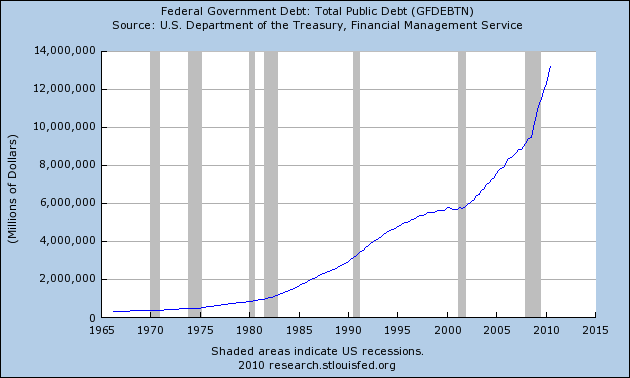 What we have done to future generations over the past 30 years is absolutely criminal. 30 years ago the U.S. national debt was a bit under one trillion dollars, and at that time it was considered a huge national crisis. Today, the national debt is 14 times larger and the years ahead look absolutely apocalyptic at this point. We have literally sold our children and our grandchildren into perpetual debt slavery. We have accumulated the biggest mountain of debt in the history of the world, and our children and our grandchildren will be burdened with it for the rest of their lives. All of our politicians keep talking about how it is vitally important that we do something about all of this debt “soon”, but they just can’t seem to stop wildly spending our money. They keep telling us that now is not the time for deficit reduction because it would harm “the economic recovery”, but the “right time” for deficit reduction never seems to come along. The national debt statistics in this article are meant to shock you. Hopefully they will shock you enough to actually take action. Up to this point, the vast majority of Americans have been extremely apathetic about the horrific crime that we are committing against future generations.
What we have done to future generations over the past 30 years is absolutely criminal. 30 years ago the U.S. national debt was a bit under one trillion dollars, and at that time it was considered a huge national crisis. Today, the national debt is 14 times larger and the years ahead look absolutely apocalyptic at this point. We have literally sold our children and our grandchildren into perpetual debt slavery. We have accumulated the biggest mountain of debt in the history of the world, and our children and our grandchildren will be burdened with it for the rest of their lives. All of our politicians keep talking about how it is vitally important that we do something about all of this debt “soon”, but they just can’t seem to stop wildly spending our money. They keep telling us that now is not the time for deficit reduction because it would harm “the economic recovery”, but the “right time” for deficit reduction never seems to come along. The national debt statistics in this article are meant to shock you. Hopefully they will shock you enough to actually take action. Up to this point, the vast majority of Americans have been extremely apathetic about the horrific crime that we are committing against future generations.
How would you feel if you found out one day that your parents had run up a million dollars in debt that now you were obligated to pay off?
Would you be absolutely furious?
Of course you would be, and rightly so.
So how do you think future generations will feel about us?
We were once the wealthiest nation on the planet, but we have taken that great inheritance and we have squandered it.
Now we are handing our children and our grandchildren the largest debt the world has ever seen.
How in the world can we do that?
How can we consign our descendants to perpetual debt slavery and still feel good about ourselves?
The America that we have all been enjoying so much today is going to be wiped out by all of this debt.
We have literally stolen the future.
We just had to keep spending more and more and more and more.
The greed of this generation will be remembered for a very, very long time.
The truth is that both political parties are responsible. Both of them have voted over and over and over to keep running up these huge budget deficits.
If you have voted for big spending Democrats at any point over the past 30 years then you have contributed to the problem. If you have voted for big spending Republicans at any point over the past 30 years then you have contributed to the problem.
Now we have reached a point where a horrific financial meltdown is basically inevitable. We are living in the greatest debt bubble in the history of the world, and it is only a matter of time until it bursts.
The following are 17 national debt statistics which prove that we have sold our children and our grandchildren into perpetual debt slavery….
#1 As of December 28th, the U.S. national debt was $13,877,230,355,933.00.
#2 If the federal government began right at this moment to repay the U.S. national debt at a rate of one dollar per second, it would take over 440,000 years to pay off the national debt.
#3 If the federal government began repaying the national debt at a rate of $10 million dollars a day it would take approximately 3,800 years to pay off the national debt.
#4 Today, the U.S. national debt is increasing by roughly 4 billion dollars every single day.
#5 The U.S. government is borrowing approximately 2.63 million more dollars every single minute.
#6 On September 30th, 1980 the U.S. national debt was 907 billion dollars. Just thirty years later, the U.S. national debt is over 14 times larger.
#7 According to a recent U.S. Treasury report to Congress, the U.S. national debt will reach 19.6 trillion dollars in 2015.
#8 It is being projected that the U.S. government will be paying 900 billion dollars just in interest on the national debt by the year 2019.
#9 A trillion $10 bills, if they were taped end to end, would wrap around the globe more than 380 times. That amount of money would still not be enough to pay off the U.S. national debt.
#10 The U.S. Congress has raised the federal debt ceiling six times in just the past three years.
#11 The 111th Congress added more to the U.S. national debt than the first 100 U.S. Congresses combined.
#12 The 111th Congress got us into so much new debt that it breaks down to $10,429.64 for each of the 308,745,538 people counted by the 2010 U.S. census.
#13 The U.S. government currently has to borrow approximately 41 cents of every single dollar that it spends.
#14 When you break down the debt that the U.S. government owes to China alone it comes to over $10,000 for every single American family.
#15 If you were alive when Christ was born and you spent one million dollars every single day since that point, you still would not have spent one trillion dollars by now. Almost unbelievably, the U.S. government will accumulate well over a trillion dollars more debt in 2011.
#16 If right this moment you went out and started spending one dollar every single second, it would take you more than 31,000 years to spend one trillion dollars.
#17 The Congressional Budget Office is projecting that U.S. government debt held by the public will reach a staggering 716 percent of GDP by the year 2080.
But the American people don’t want to hear that we have spent decades creating a horrific debt crisis that is not going to be easy to fix. They just want someone to “tweak” a few things and get us back to being the greatest economy on earth. Unfortunately, it is simply not that easy.
Just check out the chart posted below. Our debt is exploding at an almost exponential rate….
But what do you tell a nation that is completely addicted to debt?
On an individual level, it can be a lot of fun to wildly run up credit card debt, but at some point you have to stop and start paying down that debt.
Unfortunately, on a national level we can’t even get our politicians to slow down the rate at which our debt is increasing.
Sadly, the chart above does not tell the real story. It is based on fraudulent government accounting. If the government used GAAP accounting (like all public companies on Wall Street must), the numbers would look much worse.
John Williams of Shadow Government Statistics says that if the federal government would have used GAAP accounting standards to calculate the federal budget deficit for 2009, it would have been approximately 8.8 trillion dollars and that there is simply no way out of all this debt….
The government’s finances not only are out of control, but the actual deficit is not containable. Put into perspective, if the government were to raise taxes so as to seize 100% of all wages, salaries and corporate profits, it still would be showing an annual deficit using GAAP accounting on a consistent basis. In like manner, given current revenues, if it stopped spending every penny (including defense and homeland security) other than for Social Security and Medicare obligations, the government still would be showing an annual deficit. Further, the U.S. has no potential way to grow out of this shortfall.
The U.S. government is essentially bankrupt at this point. It is just a matter of playing out the hand.
The rest of the world is starting to realize this, and confidence in the U.S. dollar is beginning to significantly decline.
Things did not have to turn out this way, but Americans did not listen to the warnings and so now this is where we are at as a nation.
The next time you see a small child, look into the hopeful eyes of that child and just think about what we have done to the future of all of our children.
We have obliterated the financial future of this nation. Someone should be put into prison for all this. But instead the mainstream media treats prominent politicians from both political parties like rock stars.
The mainstream media continues to perpetuate the myth that the U.S. economy is on the road to a grand recovery and that eventually we can get a handle on all this debt and that somehow everything is going to be okay.
Well, everything is not going to be okay.
All that is on the horizon is great financial pain, and the sad thing is that it could have all been avoided.
But now the game is over and the day of reckoning is coming soon.
We are going to reap what we have sown.


